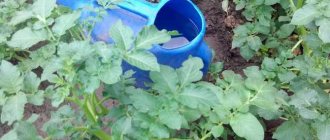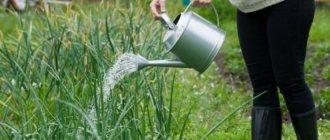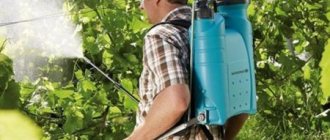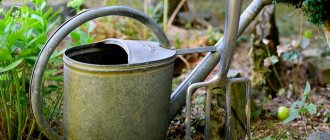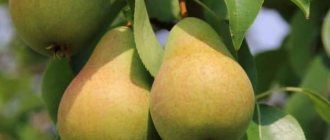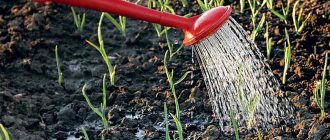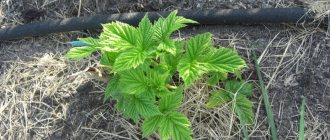Grapes need watering, thanks to the regularity of which the plant develops faster and its productivity increases. But gardeners should understand that grape leaves are very sensitive to excessive moisture accumulation.
Rainy seasons are also fraught with danger, when the fungus can cause irreparable harm. Experts are wary of irrigation. Therefore, you should study in advance the rules on how to properly water grapes.
Features of seasonal watering
Grape bushes have powerful roots that go deep into the ground. Therefore, they can withstand periods of drought quite steadfastly.
However, proper irrigation helps improve immunity and productivity. Each season has its own requirements for watering grape bushes.
Consequences of moisture deficiency and excess
With poor moisture, grapes grow many superficial roots to the detriment of the main one. Due to irregular soil moisture, the roots periodically dry out and grow back. You should not expect a good harvest from grapes that are constantly under stress. In the summer heat, overdried soil cracks, roots tear, and plants dry out.
Excess moisture causes the following consequences:
- nutrients are washed away;
- fungal diseases occur;
- roots rot;
- the berries crack and become sour;
- ripe fruits do not tolerate transportation and storage well.
If watering is not done on time, the berries take on the appearance of wrinkled balls and stop developing. They are limp and tasteless. When there is a lack of moisture, the vine loses some of its leaves, and the remaining ones become withered. During drought, in the absence of watering, spreading of the vine and roots is observed, which affects other garden plants.
Adding moisture in spring
The onset of the growing season is associated with the intensification of the development of the root system, with the growth of shoots and leaf growth. Therefore, grapes need good moisture.
In the spring, moisture-recharging irrigation is carried out, the purpose of which is to fill the soil with enough water so that it is preserved in deep layers.
The first addition of moisture is carried out until the eyes come to life. After a winter with little snow, the soil is saturated in March, and during a dry spring it is moistened in April.
It is important not only to know when to water the grapes, but also what kind of water to choose. This factor determines the moment the vine awakens, which is associated with the likelihood of repeated frosts.
It is recommended to use cold moisture if it is necessary to slow down bud break, and warm water will speed up this process.
Re-introduction of moisture is carried out three weeks before flowering. Experienced winegrowers water on average three times during the spring.
What are the benefits of summer watering?
Summer watering of grapes is necessary to maintain their vital activity.
In summer, with consistently high temperatures (above 40 °C), air humidity tends to decrease. As a result, the plant overheats. If, against the background of such changes, the vine receives moisture, then evaporation will accelerate and oxygen and nutrient exchange within the cells will be normalized. This type of watering is called vegetative watering. Therefore, summer watering helps to cool the grapes, which prevents burns, early leaf fall and damage to the crop. This way, moisture will be retained in the soil, supporting the vital processes of plant development.
Things are different in regions with a temperate climate. Then the vineyard does not really need additional moisture. But this does not mean a complete abandonment of artificial irrigation.
For grapes, both moisture deficiency and excess are bad. In the first case, the development of the vine is inhibited, it withers and droops, and the berries become smaller. The first sign of a lack of moisture is excessive growth of the vine in width and height. Then garden crops growing in the neighborhood may suffer. In the second scenario, the roots begin to rot, which leads to the death of the crop. In addition, excess water washes out useful elements from the soil that are required for the full development of the vine.
Watering in summer
Vegetative irrigation should be carried out in the summer. They provide the required degree of humidity over the entire planting area.
Processing grapes - rules and expert recommendations when and with what to spray and fertilize grapes (155 photos + video)
Forming grapes: simple formation patterns for beginners and expert advice on choosing a method (video instructions + 140 photos)
Planting grapes: photo and video tips on how to plant grapes correctly and when is the best time to plant them
Beginner winegrowers are interested in the question of whether it is possible to water the grapes during flowering. This should not be done, just as it should not be irrigated on the eve of this process. The reason is a high probability that the ovary will simply fall off or insufficient pollination will occur.
From the beginning of berry filling and throughout this period, moisture is actively consumed by the plant - up to half the seasonal norm. But even here it is important to stop watering in time. This must be done until the berries become soft.
If you continue to add moisture, the berries will begin to crack and sugar will not accumulate in sufficient quantities. Once the berries begin to color, the grapes should not be watered during ripening.
During the summer, stress should be avoided. Therefore, in hot weather, you should not water with cold water due to the temperature difference with the soil. Irrigation with heated liquid under pressure in hot weather is dangerous.
Combination of fertilizing and watering
The use of fertilizers will help increase the yield and quality of fruits. It is most necessary to fertilize in the spring. It is in the spring that you need to use mineral and organic fertilizers, as well as add microelements such as zinc, phosphorus and nitrogen. For greater efficiency, they are used in combination with organic mixtures (compost, manure, bird droppings).
In summer, grapes also need to be fed, but those containing nitrogen should be excluded from fertilizers. Organic fertilizers are most favorable for the plant in the hot summer. The latest time for applying fertilizer is 2 weeks before the crop is fully ripened and harvested.
Do not forget about watering when applying fertilizers. It is water that helps fertilizing be better absorbed and promotes the movement of the internal sap of the plant, which carries nutrients to all its parts. Regular watering not only improves immunity, but also improves the vital activity of all plantings and the quality of the resulting harvest, making it sweet and juicy.
Autumn irrigation
Watering grapes after flowering, fruiting and harvesting is aimed at providing the best conditions for wintering the bushes. If the soil is very dry in winter, the root system will begin to freeze and then crack. During rainy autumn, additional irrigation will not be required.
Boric acid for grapes: video and photo application, spraying methods and solution proportions
Maiden grapes - planting, care, propagation and features of growing ornamental grapes in the garden (95 photos and videos)
Growing grapes - simple care instructions and tips for beginners on how to properly set up a vineyard on a personal plot (95 photos + video)
Uncovered and covered vineyards are set up for wintering. The first ones are watered after the leaves fall. The latter should be moistened only after work has been done to insulate the vine. This is done before the start of frost in the last weeks of October and the first ten days of November.
There are late varieties of berries. They are often used for long-term storage. Therefore, the end of watering in the fall occurs approximately 30 days before the start of berry picking.
When to water grape bushes
Watering grapes is important at all stages of their development. The frequency and frequency of soil moisture depends on various factors: the growing region, the number of rainy days, soil composition, plant variety and age, groundwater level, and irrigation method. In areas where there is frequent heavy rain, the grape bushes are not watered at all. In the south and central Russia, plants need to ensure timely moistening of the soil near the trunk.
Watering grapes in spring
At the beginning of the growing season, roots, shoots and foliage grow quickly. After opening, while the buds have not yet swelled, the grape bushes must be well watered. After a winter with little snow, the soil should be recharged with moisture. In dry spring weather, grapes must be watered in April. The time for plants to awaken depends on the temperature of the irrigation water: warm liquid accelerates bud break, and cold liquid slows it down. This feature must be taken into account if return frosts are expected.
Most of all, grape bushes need moisture during the period of appearance of young leaves and active growth of the vine. Plants need to be watered approximately 20 days before flowers appear. On average, in spring the soil is moistened 3 times. It is not recommended to water flowering grapes. Otherwise, some of the inflorescences will fall off and there will be fewer clusters.
Advice!
It is better to moisten the soil abundantly 2-3 times than to carry out frequent and meager watering.
Watering grapes in summer
Lack of precipitation and heat are common phenomena accompanying summer weather. When the berries begin to fill, the need for moisture increases. The grapes should receive 1/2 of the seasonal water requirement. With the arrival of summer, it is watered when berries the size of a pea are formed, and the next time - in the last days of July.
It is believed that moistening the soil around the grapes in August only harms the future harvest. The soil continues to be moistened until the fruit softens and the characteristic varietal color of the skin appears. Watering grapes in the summer while the berries are ripening often leads to cracking of the skin and the development of gray rot. Late varieties are also watered in August, because their berries ripen in September or October.
Autumn watering
Is it possible to water grapes in the fall? To prepare the plants for the upcoming frosts, in the fall it is necessary to moisten the tree trunk area well. In winter, dry soil cracks and the roots freeze. If it rains frequently in the fall, the vineyard is not watered. In the southern regions, where bushes are not covered for the winter, the ground is well moistened after the leaves fall. In areas with cold climates, grapes are watered after covering. Approximate time: end of October or early November. Late-ripening varieties, the fruits of which are intended for long-term storage, stop watering a month before harvesting.
Watering frequency
There are no clear rules on how often to water grapes and in what volume. These parameters depend on numerous factors:
- In arid climates, irrigation is done more frequently.
- In the presence of light sandy soils, watering is more frequent, but the volume of one-time moisture is reduced. Irrigation of chernozems and clay soils is not as frequent, but more abundant.
- Temperature conditions in the area where the vineyard is located, average precipitation.
- Varieties and time of ripening of berries - the later the bunches ripen, the greater the number of waterings.
- Age characteristics of the vine, its size indicators, productivity.
Common mistakes gardeners make
Often, inexperienced gardeners in the process of moistening grapes make a number of mistakes that can have a detrimental effect not only on the fertility of the plant, but also lead to its death.
To avoid the most common mistakes when watering, you should follow several important rules:
- irrigation should be carried out rarely, but in sufficiently large volumes;
- For irrigation, use warm, settled water;
- do not moisturize during the flowering period, at the time of bud formation and in the ripening phase of berries;
- in very dry seasons, irrigation should be carried out in autumn and spring;
- When moistening, make sure that moisture does not get on the foliage and trunk of the crop.
Find out whether grapes can cause allergies and how they manifest themselves.
Watering is one of the most important aspects when caring for grapes. Like any other event, it must be carried out according to certain rules, schedule and taking into account the natural needs of the variety. Timely, well-organized irrigation of crops in the summer will allow you to get a rich harvest of tasty, large and juicy fruits in the autumn.
Irrigation methods
For spring watering after the winter months with little snow, use 250 liters per bush. Summer irrigation is carried out similarly during prolonged heat without rain.
During vegetative irrigation, an average of 50 liters are applied per 1 m2 of vineyard area. If the soil is sandy or sandy loam, then the volume is increased by 1.5 times. To increase the horse system, an irrigation depth of 40 cm should be provided.
You need to pay the most attention to young plants that require regular watering. Having planted young bushes, they need to be irrigated at least once every 7 days.
Summer pruning of grapes - how to properly and when is it better to prune grapes from unnecessary shoots (115 photos)
- How to tie grapes correctly on a chapalera: 115 photos and video instructions for gartering a vineyard from A to Z
Caring for grapes - useful growing tips for beginners. Planting, pruning and propagation of vineyards (95 photos and videos)
First, a hole is made up to 60 cm wide and 25 cm deep. 15 liters of water are poured into it. From July, when the bush has grown, watering is reduced to 2 times a month, and in August it should be stopped.
How to water grapes - volume of water
watering grapes
The norms for the volume of water used to irrigate grapes are influenced by a number of factors related to both the characteristics of the plant itself and the conditions of its environment. The most important points that determine the volume of water for irrigation include the following conditions:
- Climatic features of the region . In places where dry periods occur and the climate is generally dry, the grapes require more moisture.
- Soil characteristics. Watering light sandy soils is carried out more often and with smaller portions of water. Chernozem and clay soils are moistened less often, but more abundantly.
- Weather. The volume of irrigation depends not only on the general climatic picture of the region, but also on the number of sunny days, precipitation, and thermometer readings during a particular season.
- A variety of grapes . Those varieties that ripen late need more water.
- The condition of each grape bush . Watering is also affected by the age of the plant. Its dimensions. The presence of more or less bunches. Thus, adult plants in the ripening phase of the clusters should be watered in a larger volume than in the case of irrigating grape seedlings at the age of 2 years at the same time.
- The method of irrigation also affects the amount of water used for this purpose.
If the winter had little snow or no snow at all, then the grapes need a lot of water in the spring - at least 250 liters per bush.
In the event of a summer drought, the same amount of moisture will be required to compensate for the drying out of the soil.
During the period when the berries are saturated with juices, it is also necessary to use a lot of water for irrigation.
During the growing season, the volume of water for irrigation of one square meter of vineyard area ranges from 40 liters to 70 liters, the average is 50 liters.
If the soil in the vineyard is sandy loam or sandy, one and a half times more water is taken than if the soil composition is different. The soil should be shed to a depth of about 0.4 m.
Otherwise, all the moisture will go to the formation of surface roots, which are not only unable to provide the plant with the necessary nutrition, but are also likely to freeze in the winter and die.
There are a number of symptoms of soil overmoistening; if you find them, you should adjust the watering regime:
- too rapid elongation of grape shoots and the formation of a mass of stepsons;
- slow and uneven ripening of vines;
- low sugar content in fruits and watery pulp;
- Too light color in fruits of dark varieties, or other color anomalies.
Determining whether the soil in a vineyard is sufficiently moistened is quite simple. It is enough to take a little soil from under the bush and squeeze it in your hand. If it does not crumble after unclenching your fist, it means the soil is sufficiently saturated with water. In this case, you can wait with watering.
Irrigation methods
There are several ways to water grapes.
Surface
For irrigation, holes or grooves are made, which are located in the root zone of several plants. The grooves should be formed with a depth of at least 20 cm. This option is suitable for small bushes.
This method is not suitable for large bushes with a deep root system, since roots with a depth of 0.5 m or more will be deprived of moisture.
For drip irrigation, a tape is placed at a distance of 20 cm from the trunk. Thanks to this, the bush is provided with the required amount of moisture.
Underground
This method provides the best in-depth hydration. As a result, the risk of damage to the root system from frostbite is minimal. The likelihood of fungal development is reduced.
Along a row of bushes, pipes are placed in the ground at a depth of half a meter. Their diameter is about 10-15 cm. One end of the pipe should be above the soil surface at a height of 15 cm. Holes with a diameter of 12 mm are made in the lower sections of the pipe. To prevent soil penetration, the holes can be wrapped with mesh.
Drainage should be laid at the bottom of the dug trench. Broken brick or crushed stone is used. The part of the pipe that goes to the surface is protected from debris. This method is very economical and allows you to expand the irrigation area.
7. Subtleties encountered during planting watering
If you decide to plant in the spring, you will need to pour 1-2 buckets of warm water into the planting hole to warm the soil.
When the seedling is firmly established in the soil, that is, the hole is filled approximately halfway, you should saturate the soil with an additional amount of water, amounting to approximately 1-2 buckets. It is advisable to infuse the water in the sun rather than heat it yourself.
To increase the positive effect, it is advisable to regularly loosen the soil in the place where the grapes grow. Watering and fertilizing are very important. The products “Master”, “Viva”, “Kemira” are especially valued. They have an excellent effect on the growth and development of the plant.
Watering recommendations
To ensure normal development of the grapevine and good yield, you should follow these simple rules:
- With all the love of the grape bush for moisture, it is better not to allow the soil to become waterlogged.
- Do not allow excessively long intervals between waterings when the soil dries out.
- During periods of excessive growth of green shoots, it is advisable to reduce irrigation.
- There is no need to water the grapes during flowering or on the eve of the start of this process.
- Watering can be increased during dry periods.
- It is better to apply moisture in the evening, when the air and soil temperatures do not differ much.
- Water for irrigation should be taken from rain or pre-settled water.
- After irrigation, the soil is loosened the next day.
Following simple rules and preventing excessive soil moisture or dryness will help ensure the development of the grape bush and excellent yield.
How to understand that a plant does not have enough moisture?
Insufficient watering of grapes
If there is insufficient watering, the grape bunches may shrink and development will stop. The required amount of liquid per bush is 1.5 liters daily. Lack of moisture makes the berries and leaves limp, the taste deteriorates, the fruits look stale and are small in size. When looking for moisture, there may be almost no leaves left on the grape vine. Rare leaves will be limp and withered.
If there is a lack of liquid, the angle between the main vein of the grape and the leaf petiole is 50-80o. Leaves droop, which is a clear indicator of insufficient irrigation.
Despite the fact that grapes can withstand dry weather, there is no need to deplete the plant. A lack of fluid can result in the vine spreading throughout the entire area.
Important! This growth is not normal for grapes and affects the entire plant, not only the upper shoots, but also the roots.
Photo of watering grapes
How to feed grapes
Rotted manure is considered the best organic substance for feeding grapes. It must be added at the rate of up to 20 kilograms, 200-250 g of microelements (urea, superphosphate, potassium chloride) and 300 g of ash. The soil is dug up shallowly (about 7 cm) and then watered with 30 liters of warm barrel water. To get rid of the crust that has formed on the surface and improve soil aeration after watering the next day, the surface soil layer requires loosening. Then watering is repeated in mid-June: it is at this moment that flowering occurs and grapes begin to set. Already at the end of July, fertilizing (without the use of urea) is repeated simultaneously with watering, but with the addition of organic matter reduced by 3 times. To ensure the best results from fertilizing, make small holes or holes around the bush.
Basic rules for conducting procedures
When watering, agronomists recommend paying attention to the grape variety - some need constant moisture, others are drought-resistant. The quality of the soil and the climatic features of the area are also taken into account. For example, in arid regions, sandy and sandy loam soils predominate; it rarely rains, which means that the grapes need constant moisture.
When applying fertilizers, maintain a balance between organic and mineral compounds. Too much nutrition is just as dangerous as too little. For example, if you do not follow the rules for applying nitrogen fertilizers, the shoots and leaves will dry out and the formation of bunches will decrease. If complex fertilizers are applied incorrectly, the taste of the fruit and its appearance will deteriorate.
Moisten and feed the grapes early in the morning or in the evening, when there is no sun. Otherwise, the water will quickly evaporate and the plants will be left with sunburn.
